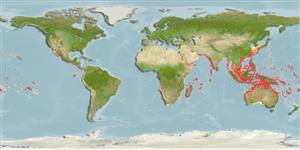Environment: milieu / climate zone / depth range / distribution range
Ekologi
laut berasosiasi dengan karang; kisaran kedalaman 1 - 100 m (Ref. 48635). Tropical; 35°N - 37°S
Indo-Pacific: Red Sea and East Africa to the Hawaiian, Marquesan and Tuamoto islands, north to southern Japan and the Ogasawara Islands, south to Australia and New Zealand.
Size / Weight / umur
Maturity: Lm ? range ? - ? cm
Max length : 40.0 cm TL jantan/; (Ref. 3392); common length : 20.0 cm TL jantan/; (Ref. 3392)
Duri punggung (Keseluruhan (total)) : 7; duri punggung lunak (Keseluruhan (total)) : 9; Duri dubur: 0; Sirip dubur lunak: 6 - 7. Heavily armored box-like body and wing-like pectoral fins (Ref. 37816).
Inhabit coastal waters with sandy substrates (Ref. 1602, 48635); a shallow-living species, benthic in adults; only species found in oceanic islands (Ref. 27821). Solitary, well-camouflaged and slow-moving (Ref. 37816, 48635). Feed on crustaceans, clams, and small fish. May be caught using ring nets (Ref. 5213).
Life cycle and mating behavior
Kematangan | Reproduksi, perkembang biakan | Pemijahan | telur-telur | Fecundity | Larva
Paxton, J.R., D.F. Hoese, G.R. Allen and J.E. Hanley, 1989. Pisces. Petromyzontidae to Carangidae. Zoological Catalogue of Australia, Vol. 7. Australian Government Publishing Service, Canberra, 665 p. (Ref. 7300)
Status IUCN Red List (Ref. 130435: Version 2024-2)
ancaman kepada manusia
Harmless
penggunaan manusia
Perikanan: nilai komersial kecil; Akuarium: Komersial
Alat, peralatan
laporan khas
muat turun XML
Sumber internet
Estimates based on models
Preferred temperature (Ref.
123201): 23.3 - 29, mean 27.8 °C (based on 1738 cells).
Phylogenetic diversity index (Ref.
82804): PD
50 = 0.5234 [Uniqueness, from 0.5 = low to 2.0 = high].
Bayesian length-weight: a=0.00550 (0.00229 - 0.01319), b=3.09 (2.88 - 3.30), in cm total length, based on LWR estimates for this (Sub)family-body shape (Ref.
93245).
Trophic level (Ref.
69278): 3.7 ±0.55 se; based on food items.
Generation time: 0.7 ( na - na) years. Estimated as median ln(3)/K based on 1
growth studies.
Daya lenting (Ref.
120179): Tinggi, Waktu penggandaan populasi minimum kurang dari 15 bulan (Preliminary K or Fecundity.).
Fishing Vulnerability (Ref.
59153): Low vulnerability (18 of 100).
Nutrients (Ref.
124155): Calcium = 86.6 [38.6, 195.6] mg/100g; Iron = 0.876 [0.407, 2.444] mg/100g; Protein = 18 [16, 20] %; Omega3 = 0.142 [0.060, 0.444] g/100g; Selenium = 70.6 [30.3, 174.1] μg/100g; VitaminA = 29.6 [9.4, 93.3] μg/100g; Zinc = 1.27 [0.80, 1.93] mg/100g (wet weight);
